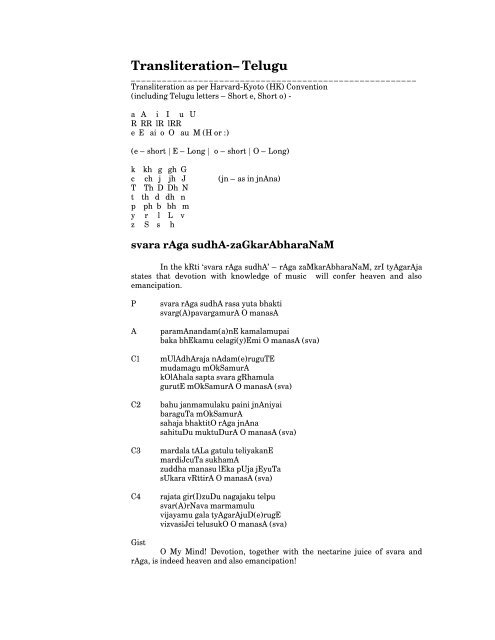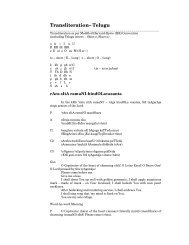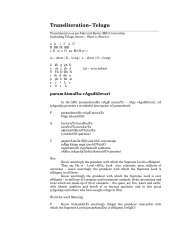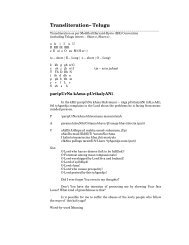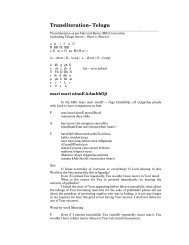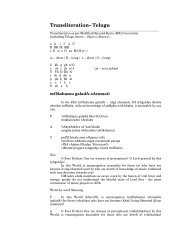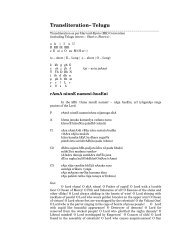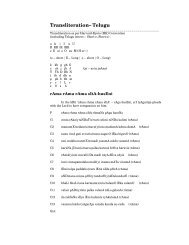svara rAga sudhA-zaGkarAbharaNaM - Gaanapriya
svara rAga sudhA-zaGkarAbharaNaM - Gaanapriya
svara rAga sudhA-zaGkarAbharaNaM - Gaanapriya
Create successful ePaper yourself
Turn your PDF publications into a flip-book with our unique Google optimized e-Paper software.
Transliteration–Telugu<br />
_______________________________________________________<br />
Transliteration as per Harvard-Kyoto (HK) Convention<br />
(including Telugu letters – Short e, Short o) -<br />
a A i I u U<br />
R RR lR lRR<br />
e E ai o O au M (H or :)<br />
(e – short | E – Long | o – short | O – Long)<br />
k kh g gh G<br />
c ch j jh J (jn – as in jnAna)<br />
T Th D Dh N<br />
t th d dh n<br />
p ph b bh m<br />
y r l L v<br />
z S s h<br />
<strong>svara</strong> <strong>rAga</strong> <strong>sudhA</strong>-<strong>zaGkarAbharaNaM</strong><br />
In the kRti ‘<strong>svara</strong> <strong>rAga</strong> <strong>sudhA</strong>’ – <strong>rAga</strong> zaMkarAbharaNaM, zrI tyAgarAja<br />
states that devotion with knowledge of music will confer heaven and also<br />
emancipation.<br />
P<br />
A<br />
C1<br />
C2<br />
C3<br />
C4<br />
<strong>svara</strong> <strong>rAga</strong> <strong>sudhA</strong> rasa yuta bhakti<br />
svarg(A)pavargamurA O manasA<br />
paramAnandam(a)nE kamalamupai<br />
baka bhEkamu celagi(y)Emi O manasA (sva)<br />
mUlAdhAraja nAdam(e)ruguTE<br />
mudamagu mOkSamurA<br />
kOlAhala sapta <strong>svara</strong> gRhamula<br />
gurutE mOkSamurA O manasA (sva)<br />
bahu janmamulaku paini jnAniyai<br />
baraguTa mOkSamurA<br />
sahaja bhaktitO <strong>rAga</strong> jnAna<br />
sahituDu muktuDurA O manasA (sva)<br />
mardala tALa gatulu teliyakanE<br />
mardiJcuTa sukhamA<br />
zuddha manasu lEka pUja jEyuTa<br />
sUkara vRttirA O manasA (sva)<br />
rajata gir(I)zuDu nagajaku telpu<br />
svar(A)rNava marmamulu<br />
vijayamu gala tyAgarAjuD(e)rugE<br />
vizvasiJci telusukO O manasA (sva)<br />
Gist<br />
O My Mind! Devotion, together with the nectarine juice of <strong>svara</strong> and<br />
<strong>rAga</strong>, is indeed heaven and also emancipation!
O My Mind! Of what avail if a crane (and/or) a frog enjoys on the Lotus<br />
called Supreme Bliss<br />
Knowing the nAda emanating from mUlAdhara is, indeed the blissfull<br />
emancipation; O My Mind! Recognising the locations (in the body) of uproarious<br />
seven <strong>svara</strong>s is indeed emancipation.<br />
It is also emancipation to shine by becoming a wisemen after many<br />
births; but, one endowed with the true knowledge (of/and) music together with<br />
co-born devotion is indeed the emancipated (while still alive).<br />
Is it enjoyable to beat the percussion instrument without knowing the<br />
pace (and/of) beat O My Mind! To perform worship without a pure mind is a<br />
piggish behaviour.<br />
The secrets of the treatise ‘svarArNava’ which Lord ziva – the Lord of<br />
snow mountain tells pArvati – daughter of himavAn, are known to this victorious<br />
tyAgarAja; O My Mind! understand it by believing (the statement of this<br />
tyAgarAja).<br />
Word-by-word Meaning<br />
P O My Mind (manasA)! Devotion (bhakti), together with (yuta) the<br />
nectarine (<strong>sudhA</strong>) juice (rasa) of <strong>svara</strong> and <strong>rAga</strong>, is indeed heaven (svarga) and<br />
also emancipation (apavargamu) (svargApavargamurA)!<br />
A O My Mind (manasA)! Of what avail (Emi) if a crane (baka) (and/or) a<br />
frog (bhEkamu) enjoys (celagi) (celagiyEmi) on the Lotus (kamalamupai) called<br />
(anE) Supreme (parama) Bliss (Anandamu) (paramAnandamanE)<br />
O My Mind! Devotion, together with the nectarine juice of <strong>svara</strong> and<br />
<strong>rAga</strong>, is indeed heaven and also emancipation!<br />
C1 Knowing (erugTE) the nAda (nAdamu) (nAdameruguTE) emanating<br />
from mUlAdhara (mUlAdhAraja) is, indeed the blissfull (mudamagu)<br />
emancipation (mOkSamu) (mOkSamura);<br />
O My Mind (manasA)! Recognising (gurutu) (gurutE) the locations<br />
(gRhamula) (in the body) of primal sounds (kOlAhala) (literally uproarious) of<br />
the seven (sapta) <strong>svara</strong>s is indeed emancipation (mOkSamu) (mOkSamurA);<br />
O My Mind! Devotion, together with the nectarine juice of <strong>svara</strong> and<br />
<strong>rAga</strong>, is indeed heaven and also emancipation!<br />
C2 It is also emancipation (mOkSamu) (mOkSamurA) to shine (baraguTa)<br />
by becoming a wisemen (jnAni) (jnAniyai) after (paini) many (bahu) births<br />
(janmamulaku); but,<br />
One endowed with (sahituDu) the true knowledge (jnAna) (of/and)<br />
music (<strong>rAga</strong>) together with co-born (sahaja) devotion (bhakti) (bhaktitO) is<br />
indeed the emancipated (muktuDu) (literally freed) (while still alive);<br />
O My Mind! Devotion, together with the nectarine juice of <strong>svara</strong> and<br />
<strong>rAga</strong>, is indeed heaven and also emancipation!<br />
C3 Is it enjoyable (sukhamA) (literally comfort) to beat (mardiJcuta) the<br />
percussion instrument (mardala) without knowing (teliyakanE) the pace (gati)<br />
(and/of) beat (taLa)<br />
O My Mind (manasA)! To perform (jEyuTa) worship (pUja) without<br />
(lEka) a pure (suddha) mind (manasu) is a piggish (sUkara) behaviour (vRtti)<br />
(vRttirA) (literally rolling);<br />
O My Mind! Devotion, together with the nectarine juice of <strong>svara</strong> and<br />
<strong>rAga</strong>, is indeed heaven and also emancipation!<br />
C4 The secrets (marmamulu) of the treatise ‘svarArNava’ (literally Ocean<br />
(arNava) of <strong>svara</strong> (svarArNava)) which Lord ziva – the Lord (IzuDu) of snow
(rajata) (literally silver) mountain (giri) (girIzuDu) tells (telpu) pArvati –<br />
daughter of himavAn (naga) (nagajaku),<br />
are known (erugE) to this victorious (vijayamu gala) tyAgarAja<br />
(tyAgarAjuDu) (tyAgarAjuDerugE); O My Mind (manasA)! understand<br />
(telusukO) it by believing (vizvasiJci) (the statement of this tyAgarAja);<br />
O My Mind! Devotion, together with the nectarine juice of <strong>svara</strong> and<br />
<strong>rAga</strong>, is indeed the heaven and also emancipation!<br />
Notes –<br />
A – baka bhEka – The honey-bee is the one which can really enjoy the<br />
nectarine juice of (Lotus) flower. Interposing the pallavi wherein <strong>svara</strong> and <strong>rAga</strong><br />
have been compared to nectarine juice, ‘a persons endowed with devotion<br />
together with (knowledge of) <strong>svara</strong> and <strong>rAga</strong>’ seems to be the ‘honey-bee’.<br />
Therefore, the purport, in my humble opinion is ‘only a devotee endowed<br />
with knowledge of <strong>svara</strong> and <strong>rAga</strong> can enjoy the nectarine juice of the Lotus<br />
called the Supreme Bliss (paramAnanda) of nAda’. Contrari-wise, anyone else –<br />
though knowledgeable in music but does not have devotion – cannot enjoy the<br />
Supreme Bliss of nAda – indeed, is an usurper on music like crane and frog on<br />
Lotus flower.<br />
C1 – mUlAdhara – Please visit the following website for getting a graphic<br />
images of the chakras - http://www.adishakti.org/subtle_system.htm<br />
C1 – mulAdhAraja nAdamu - "para nAda (vANi): (The Transcendental<br />
Sound) The Primal Sound’s seat is at the Muladhara plane of Kundalini. It is<br />
undifferentiated sound, though it is the source of root ideas or germ thoughts. It<br />
is not within the reach of ordinary consciousness. Nada Yogis claim that Para<br />
Nada is a high frequency sound, so high that it does not stir or produce<br />
vibrations; it is a still sound"<br />
Origin and manifestation of nAda is explained in the site -<br />
http://www.bhagavadgitausa.com/SOUND.htm<br />
C1 – kOlAhala – Uproar, loud and confused sound. The reason why zrI<br />
tyAgarAja uses this word together with ‘sapta <strong>svara</strong> gRhamulu’ is not clear.<br />
“Anahata sounds are the mystic sounds heard by the Yogin during his<br />
meditation”. Details of ‘anAhata nAda’ may be found in the e-book ‘kuNDalini<br />
yOga’ by Swami Sivananda downloadable from – http://www.dlshq.org/<br />
C1 – sapta <strong>svara</strong> gRhamulu – It is not clear whether the seven chakras<br />
are meant to represent the sapta <strong>svara</strong>s; if that be so the correspondence would<br />
be – mUlAdhAra – sa; svAdhiSThAna – ri; maNipUra - ga; anAhata -<br />
ma;vizuddhi - pa; AjnA - da; sahasrAra – ni.<br />
“The notes are viewed to have an organic unity. Thus sa is said to be the<br />
atman, ri the head, ga the arms, ma the chest, pa the throat, dha the lips, and ni<br />
the feet. These seven limbs evoke a presence, and give birth to the devas.” Source<br />
- http://www.ece.lsu.edu/kak/manila.pdf<br />
In regard to sapta <strong>svara</strong>s and their relation to the seven charkras, there is<br />
an interesting article in the website –<br />
http://www.newtalavana.org/ebooks/sapta<strong>svara</strong>h.pdf#search='sapta<strong>svara</strong>'<br />
C2 – bahu janmamulaku – In this regard, the following verse of zrImad<br />
bhagavat gItA, Chapter 7 is relevant –<br />
bahUnAM janmanAmantE jnAnavAnmAM prapadyatE |<br />
vAsudEva: sarvamiti sa mahAtmA sudurlabha: || 19 ||<br />
“At the end of many births, the man of wisdom takes refuge in Me,<br />
realising that all this is vAsudEva (the innermost Self). Very rare is that great<br />
soul.” (Translation by Swami Swarupananda)
C2 – sahaja bhakti – Though ‘sahaja’ may be translated as ‘natural’ or<br />
‘innate’, in my humble opinion, the kind of devotion which one imbibes from the<br />
childhood as that of prahlAda is what meant here. In this regard, the kRti of zrI<br />
tyAgarAja ‘cinna nADE nA ceyyi paTTitivE’ is relevant. prahlAda, dhruva,<br />
mArkaNDeya, rukmaNi, rAdhA, mIrA, ANDAL and tirujnAna sambandar<br />
(tamizh saint) are a few other examples of child bhaktAs. The bhakti of these<br />
personages is what zrI tyAgarAja terms as ‘sahaja bhakti’.<br />
C3 – mardala – In all the books it is given as ‘maddaLa’. In telugu it is<br />
called either ‘mardala’ or ‘maddela’ derived from saMskRta word ‘mardala’. In<br />
tamizh, this is called ‘mattaLam’. Therefore, the telugu word ‘mardala’ has been<br />
adopted here.<br />
C3 – tALa gati – to know intricacies of the tALa and gati, please visit the<br />
website - http://www.carnatica.net/sangeet/layanubhava2.htm<br />
C4 – svarArNava – Though literally this means ‘Ocean of <strong>svara</strong>s’, it is<br />
stated that a treatise by that name came in the possession of zrI tyAgarAja by the<br />
grace of sage nArada whom zrI tyAgarAja considered as his guru. The story of<br />
how the treatise came in the possession of zrI tyAgarAja is told by the great<br />
harikatha exponent Brahma Shri TS Balakrishna Sastrigal in his ‘Thyagaraja<br />
Charitram’. The full-story of the same may be found in the website –<br />
http://www.sangeetham.com/tsintro_13mar.htm<br />
General – In this kRti, zrI tyAgarAja describes ‘nAdOpAsana’ as a means<br />
of emancipation. However, in other philosophical treatises, like zrImadbhagavad-gItA,<br />
the subject of music is not at all discussed. Therefore, knowledge<br />
of music is not sine-quo-non for emancipation.<br />
Devanagari<br />
{É. º´É®ú ®úÉMÉ ºÉÖvÉÉ ®úºÉ ªÉÖiÉ ¦ÉÊHò<br />
º´É(MÉÉÇ){É´ÉMÉǨÉÖ®úÉ +Éä ¨ÉxɺÉÉ<br />
+. {É®ú¨ÉÉxÉxnù¨ÉxÉä Eò¨Éô¨ÉÖ{Éè<br />
¤ÉEò ¦ÉäEò¨ÉÖ SÉäôÊMÉ(ªÉä)欃 +Éä ¨ÉxɺÉÉ (º´É)<br />
SÉ1. ¨ÉÚôÉvÉÉ®úVÉ xÉÉnù(¨Éä)¯ûMÉÖ]äõ<br />
¨ÉÖnù¨ÉMÉÖ ¨ÉÉäIɨÉÖ®úÉ<br />
EòÉäôɽþô ºÉ”É º´É®ú MÉÞ½þ¨ÉÖô<br />
MÉÖ¯ûiÉä ¨ÉÉäIɨÉÖ®úÉ +Éä ¨ÉxɺÉÉ (º´É)<br />
SÉ2. ¤É½Öþ VÉx¨É¨ÉÖôEÖò {ÉèÊxÉ YÉÉÊxɪÉè<br />
¤É®úMÉÖ]õ ¨ÉÉäIɨÉÖ®úÉ<br />
ºÉ½þVÉ ¦ÉÊHòiÉÉä ®úÉMÉ YÉÉxÉ<br />
ºÉʽþiÉÖbÖ÷ ¨ÉÖHÖòbÖ÷®úÉ +Éä ¨ÉxɺÉÉ (º´É)<br />
SÉ3. ¨ÉnÇùô iÉɳý MÉiÉÖÖô iÉäÊôªÉEòxÉä<br />
¨ÉÌnùˆÉÖ]õ ºÉÖJɨÉÉ<br />
ÉÖrù ¨ÉxɺÉÖ äôEò {ÉÚVÉ VÉäªÉÖ]õ<br />
ºÉÚEò®ú ´ÉÞÊkÉ®úÉ +Éä ¨ÉxɺÉÉ (º´É)
SÉ4. ®úVÉiÉ ÊMÉ(®úÒ)ÉÖbÖ÷ xÉMÉVÉEÖò iÉä±{ÉÖ<br />
º´É®úÉhÉÇ´É ¨É¨ÉǨÉÖÖô<br />
Ê´ÉVɪɨÉÖ MÉô iªÉÉMÉ®úÉVÉÖ(bä÷)¯ûMÉä<br />
Ê´É·ÉʺÉÊˆÉ iÉäÖôºÉÖEòÉä +Éä ¨ÉxɺÉÉ (º´É)<br />
English with Special Characters<br />
pa. <strong>svara</strong> r¡ga sudh¡ rasa yuta bhakti<br />
sva(rg¡)pavargamur¡ ° manas¡<br />
a. param¡nandaman® kamalamupai<br />
baka bh®kamu celagi(y®)mi ° manas¡ (sva)<br />
ca1. m£l¡dh¡raja n¡da(me)rugu®<br />
mudamagu m°kÀamur¡<br />
k°l¡hala sapta <strong>svara</strong> g¤hamula<br />
gurut® m°kÀamur¡ ° manas¡ (sva)<br />
ca2. bahu janmamulaku paini jμ¡niyai<br />
baragua m°kÀamur¡<br />
sahaja bhaktit° r¡ga jμ¡na<br />
sahitu·u muktu·ur¡ ° manas¡ (sva)<br />
ca3. mardala t¡½a gatulu teliyakan®<br />
mardiμcua sukham¡<br />
¿uddha manasu l®ka p£ja j®yua<br />
s£kara v¤ttir¡ ° manas¡ (sva)<br />
ca4. rajata gi(r¢)¿u·u nagajaku telpu<br />
svar¡r¸ava marmamulu<br />
vijayamu gala ty¡gar¡ju(·e)rug®<br />
vi¿vasiμci telusuk° ° manas¡ (sva)<br />
Telugu<br />
xms. xqs*LRi LSgRi xqsVμ³y LRixqs ¸RVV»R½ ˳ÏÁNTPò
xqs*(LæS)xmsª«sLæRiª«sVVLS J ª«sV©«sry<br />
@. xmsLRiª«sW©«s©ô«sª«sV®©s[ NRPª«sVÌÁª«sVV\|ms<br />
ÊÁNRP Û˳Á[NRPª«sVV ¿ÁÌÁgji(¹¸[V)−sV J ª«sV©«sry (xqs*)<br />
¿RÁ1. ª«sVWÍØμ³yLRiÇÁ ©yμR(®ªsV)LRiVgRiVÛÉÁ[<br />
ª«sVVμRª«sVgRiV ®ªsWORPQª«sVVLS<br />
N][ÍØx¤¦¦¦ÌÁ xqsxmsò xqs*LRi gRiXx¤¦¦¦ª«sVVÌÁ<br />
gRiVLRiV¾»½[ ®ªsWORPQª«sVVLS J ª«sV©«sry (xqs*)<br />
¿RÁ2. ÊÁx¤¦¦¦§ ÇÁ©«søª«sVVÌÁNRPV \|ms¬s Çìجs\¹¸V<br />
ÊÁLRigRiVÈÁ ®ªsWORPQª«sVVLS<br />
xqsx¤¦¦¦ÇÁ ˳ÏÁNTPò»][ LSgRi ÇìØ©«s<br />
xqsz¤¦¦¦»R½V²RV ª«sVVNRPVò²RVLS J ª«sV©«sry (xqs*)<br />
¿RÁ3. ª«sVLôRiÌÁ »yÎÏÁ gRi»R½VÌÁV ¾»½ÖÁ¸RVNRP®©s[<br />
ª«sVLôjiÄÁVèÈÁ xqsVÅÁª«sW<br />
aRPVμôðR ª«sV©«sxqsV ÛÍÁ[NRP xmspÇÁ ÛÇÁ[¸RVVÈÁ<br />
xqsWNRPLRi ª«sX¼½òLS J ª«sV©«sry (xqs*)<br />
¿RÁ4. LRiÇÁ»R½ gji(Lki)aRPV²RV ©«sgRiÇÁNRPV ¾»½ÌÁVö<br />
xqs*LSLñRiª«s ª«sVLRiøª«sVVÌÁV<br />
−sÇÁ¸RVª«sVV gRiÌÁ »yùgRiLSÇÁÙ(®²)LRiVlgi[<br />
−saRP*zqsÄÓÁè ¾»½ÌÁVxqsVN][ J ª«sV©«sry (xqs*)<br />
Tamil<br />
T. vYW WôL 3 ^÷Rô 4 W^ ÙR T 4 d§<br />
vYo(Lô 3 )TYoL 3 ØWô K U]^ô<br />
A. TW(Uô)]kR 3 Uú] LUXØûT<br />
T 3 L úT 4 LØ ùNX¡ 3 (úV)ª K U]^ô (vY)<br />
N1. êXôRô 4 W_ SôR 3 (ùU)ÚÏ 3 úP<br />
ØR 3 UÏ 3 úUôbØWô<br />
úLôXôaX ^lR vYW dÚaØX<br />
Ï 3 ÚúR úUôbØWô K U]^ô (vY)<br />
N2. T 3 a÷ _]UØXÏ ûT² Oô²ûV<br />
T 3 WÏ 3 P úUôbØWô<br />
^a_ T 4 d§úRô WôL 3 Oô]<br />
^ÕÓ 3 ØdÕÓ 3 Wô K U]^ô (vY)<br />
N3. UoR 3 X Rô[ L 3 ÕÛ ùR−VLú]<br />
Uo§ 3 gÑP ^÷L 2 Uô<br />
^÷j 3 R 3 U]^÷ úXL é_ ú_ÙP<br />
^øLW qÚj§Wô K U]^ô (vY)
N4. W_R ¡ 3 (Ã)^÷Ó 3 SL 3 _Ï ùRp×<br />
vY(Wô)oQY UoUØÛ<br />
®_VØ L 3 X jVôL 3 Wô_÷(ùP 3 )ÚúL 3<br />
®vY³g£ ùRÛ^÷úLô K U]^ô (vY)<br />
TRm Utßm TiùQàm AØRf NôtßPu á¥V Tj§<br />
YôàXLØm úUôdLØUôÏUPô, H U]úU!<br />
úTWô]kRùUàm LUXj§u ÁÕ<br />
ùLôdÏm RYû[Ùm §LrkùRu] (TVu), H U]úU<br />
TRm Utßm TiùQàm AØRf NôtßPu á¥V Tj§<br />
YôàXLØm úUôdLØUôÏUPô, H U]úU!<br />
1. êXôRôWj§Û§dÏm SôRj§û]V±Rp<br />
L°l×ûP úUôdLUPô!<br />
úLôXôLXUô] HrlTReL°u CÚl©Pm<br />
ùR¬RúX úUôdLUPô, H U]úU!<br />
TRm Utßm TiùQàm AØRf NôtßPu á¥V Tj§<br />
YôàXLØm úUôdLØUôÏUPô, H U]úU!<br />
2. TX ©\®LÞdÏl ©u Oô²Vô¡j<br />
§LrRp úUôdLUPô!<br />
EPu ©\kR Tj§ÙPu TiQ±Üm<br />
EûPúVôu ØjR]Pô, H U]úU!<br />
TRm Utßm TiùQàm AØRf NôtßPu á¥V Tj§<br />
YôàXLØm úUôdLØUôÏUPô, H U]úU!<br />
3. UjR[j§u Rô[ SûPL[±VôÕ<br />
(UjR[j§û]) C¥jRp ÑLUô<br />
çV Es[ªu±j ùRôÝûL ùNnRp<br />
Tu±ùVôÝdLUPô, H U]úU!<br />
TRm Utßm TiùQàm AØRf NôtßPu á¥V Tj§<br />
YôàXLØm úUôdLØUôÏUPô, H U]úU!<br />
4. T² UûXÂNu UûXULÞdÏj ùR¬®dÏm<br />
TRdLP−u UÚUeLs<br />
ùYt±ÙûPj §VôLWôNu A±Yôú]!<br />
Sm©j ùR¬kÕùLôsYôn, H U]úU!<br />
TRm Utßm TiùQàm AØRf NôtßPu á¥V Tj§<br />
YôàXLØm úUôdLØUôÏUPô, H U]úU!<br />
TRm þ (HÝ) ÑWeLs<br />
Ti þ CWôLm<br />
êXôRôWm þ Bß BRôWj§ùXôuß þ ÏRjRô]m<br />
T² UûXÂNu þ £Yu<br />
UûXULs þ TôoY§
Kannada<br />
®Ú. ÑÚÊÁÚ ÁÛVÚ ÑÚß¨Û ÁÚÑÚ ¾Úßß}Ú ºÚP¡<br />
ÑÚÊ(ÁÛX)®ÚÈÚÁÚXÈÚßßÁÛ K ÈÚß«ÚÑÛ<br />
@. ®ÚÁÚÈÚáÛ«Ú«Ú§ÈÚß«æÞ OÚÈÚßÄÈÚßß®æç<br />
OÚ ºæÞOÚÈÚßß ^æÄW(¾æßÞ)Éß K ÈÚß«ÚÑÛ (ÑÚÊ)<br />
^Ú1. ÈÚßàÅÛ¨ÛÁÚd «Û¥Ú(Èæß)ÁÚßVÚßmæÞ<br />
ÈÚßߥÚÈÚßVÚß ÈæàÞOÚÐÈÚßßÁÛ<br />
OæàÞÅÛÔÚÄ ÑÚ®Ú¡ ÑÚÊÁÚ VÚäÔÚÈÚßßÄ<br />
VÚßÁÚß}æÞ ÈæàÞOÚÐÈÚßßÁÛ K ÈÚß«ÚÑÛ (ÑÚÊ)<br />
^Ú2. ÔÚß d«Ú½ÈÚßßÄOÚß ®æç¬ eÛk¬¾æßç<br />
ÁÚVÚßl ÈæàÞOÚÐÈÚßßÁÛ<br />
ÑÚÔÚd ºÚP¡}æàÞ ÁÛVÚ eÛk«Ú<br />
ÑÚÕ}ÚßsÚß ÈÚßßOÚß¡sÚßÁÛ K ÈÚß«ÚÑÛ (ÑÚÊ)<br />
^Ú3. ÈÚßÁÚ§Ä }Û×Ú VÚ}ÚßÄß }æƾÚßOÚ«æÞ<br />
ÈÚߧjß`l ÑÚßRÈÚáÛ<br />
ËÚߥڪ ÈÚß«ÚÑÚß ÅæÞOÚ ®Úãd eæÞ¾Úßßl<br />
ÑÚàOÚÁÚ ÈÚä~¡ÁÛ K ÈÚß«ÚÑÛ (ÑÚÊ)<br />
^Ú4. ÁÚd}Ú W(ÂÞ)ËÚßsÚß «ÚVÚdOÚß }æÄß°<br />
ÑÚÊÁÛÁÚ|ÈÚ ÈÚßÁÚ½ÈÚßßÄß<br />
Éd¾ÚßÈÚßß VÚÄ }ÛÀVÚÁÛdß(sæ)ÁÚßVæÞ<br />
ÉËÚÊÒjÝ` }æÄßÑÚßOæàÞ K ÈÚß«ÚÑÛ (ÑÚÊ)<br />
Malayalam<br />
]. kzc cmK kp[m ck bpX `àn<br />
kz(cvKm)]hcvKapcm Hm a\km<br />
A. ]cam\μat\ Iaeapss]<br />
_I t`Iap sNeKn(tb)an Hm a\km (kz)<br />
N1. aqem[mcP \mZ(sa)cpKptS<br />
apZaKp tam£apcm
tImemle k]vX kzc Krlape<br />
KpcptX tam£apcm Hm a\km (kz)<br />
N2. _lp P·apeIp ss]\n Úm\nssb<br />
_cKpS tam£apcm<br />
klP `àntXm cmK Úm\<br />
klnXpUp apàpUpcm Hm a\km (kz)<br />
N3. acvZe Xmf KXpep sXenbIt\<br />
acvZn©pS kpJam<br />
ip² a\kp teI ]qP tPbpS<br />
kqIc hr¯ncm Hm a\km (kz)<br />
N4. cPX Kn(co)ipUp \KPIp sXev]p<br />
kzcmcvWh acvaapep<br />
hnPbap Ke XymKcmPp(sU)cptK<br />
hnizkn©n sXepkptIm Hm a\km (kz)<br />
Assamese<br />
Y. º¾» »çG aÇWýç »a Ì^ÇTö \ö×Nþ<br />
º¾(Gïç)Y¾Gï]Ç»ç C ]Xaç<br />
%. Y»]çX³V]ãX Eõ]_]ÇêY<br />
[ýEõ å\öEõ]Ç æ$Jô_×G(åÌ^)×] C ]Xaç (º¾)<br />
$Jô1. ]É_çWýç»L XçV(å])»ÓmäOô<br />
]ÇV]m å]çlù]Ç»ç<br />
åEõç_çc÷_ aŠ º¾» GÊc÷]Ç_<br />
m»ÓãTö å]çlù]Ç»ç C ]Xaç (º¾)<br />
$Jô2. [ý§ LX½]Ç_EÇõ éY×X pûç×XêÌ^<br />
[ý»mOô å]çlù]Ç»ç<br />
ac÷L \ö×NþãTöç »çG pûçX<br />
a×c÷TÇöQÇö ]ÇNÇþQÇö»ç C ]Xaç (º¾)<br />
$Jô3. ]VÛ_ Töç_ GTÇö_Ç åTö×_Ì^EõãX<br />
]×VÛ‡ÇûOô aÇF]ç<br />
£ˆù ]XaÇ å_Eõ YÉL åLÌ^ÇOô<br />
aÉEõ» ¾Ê×wø»ç C ]Xaç (º¾)
$Jô4. »LTö ×G(»Ý)£QÇö XGLEÇõ åTö”Ç<br />
º¾»çSï¾ ]]ï]Ç_Ç<br />
×¾LÌ^]Ç G_ ±Ì^çG»çLÇ(åQö)»ÓãG<br />
×¾¸¾×aׇû åTö_ÇaÇãEõç C ]Xaç (º¾)<br />
Bengali<br />
Y. Ø‘öÌ[ý Ì[ýçG aÇWýç Ì[ýa Ì^ÇTö \ö×Nþ<br />
Ø‘ö(Gïç)Y[ýGï]ÇÌ[ýç C ]Xaç<br />
%. YÌ[ý]çX³V]ãX Eõ]_]ÇêY<br />
[ýEõ å\öEõ]Ç æ»Jô_×G(åÌ^)×] C ]Xaç (Ø‘ö)<br />
»Jô1. ]É_çWýçÌ[ýL XçV(å])Ì[ýÓmäOô<br />
]ÇV]m å]çlù]ÇÌ[ýç<br />
åEõç_çc÷_ aŠ Ø‘öÌ[ý GÊc÷]Ç_<br />
mÌ[ýÓãTö å]çlù]ÇÌ[ýç C ]Xaç (Ø‘ö)<br />
»Jô2. [ý§ LX½]Ç_EÇõ éY×X pûç×XêÌ^<br />
[ýÌ[ýmOô å]çlù]ÇÌ[ýç<br />
ac÷L \ö×NþãTöç Ì[ýçG pûçX<br />
a×c÷TÇöQÇö ]ÇNÇþQÇöÌ[ýç C ]Xaç (Ø‘ö)<br />
»Jô3. ]VÛ_ Töç_ GTÇö_Ç åTö×_Ì^EõãX<br />
]×VÛ‡ÇûOô aÇF]ç<br />
£ˆù ]XaÇ å_Eõ YÉL åLÌ^ÇOô<br />
aÉEõÌ[ý [ýÊ×wøÌ[ýç C ]Xaç (Ø‘ö)<br />
»Jô4. Ì[ýLTö ×G(Ì[ýÝ)£QÇö XGLEÇõ åTö”Ç<br />
Ø‘öÌ[ýçSï[ý ]]ï]Ç_Ç<br />
×[ýLÌ^]Ç G_ ±Ì^çGÌ[ýçLÇ(åQö)Ì[ýÓãG<br />
×[ý`Ÿ×aׇû åTö_ÇaÇãEõç C ]Xaç (Ø‘ö)
Gujarati<br />
~É. »´É−÷ −÷ÉNÉ »ÉÖyÉÉ −÷»É «ÉÖlÉ §ÉÎGlÉ<br />
»´É(NÉÉÇ)~É´ÉNÉÇ©ÉÖ−÷É +Éà ©É{É»ÉÉ<br />
+. ~É−÷©ÉÉ{É{qö©É{Éà Hí©É±É©ÉÖ~Éä<br />
¥ÉHí §ÉàHí©ÉÖ SÉè±ÉÊNÉ(«Éà)Ê©É +Éà ©É{É»ÉÉ (»´É)<br />
SÉ1. ©ÉÚ±ÉÉyÉÉ−÷Wð {ÉÉqö(©Éè)®øNÉÖ`àò<br />
©ÉÖqö©ÉNÉÖ ©ÉÉàKÉ©ÉÖ−÷É<br />
HíÉà±Éɾú±É »É~lÉ »´É−÷ NÉÞ¾ú©ÉÖ±É<br />
NÉÖ®ølÉà ©ÉÉàKÉ©ÉÖ−÷É +Éà ©É{É»ÉÉ (»´É)<br />
SÉ2. ¥É¾Öú Wð{©É©ÉÖ±ÉHÖí ~ÉäÊ{É [ÉÉÊ{É«Éä<br />
¥É−÷NÉÖ`ò ©ÉÉàKÉ©ÉÖ−÷É<br />
»É¾úWð §ÉÎGlÉlÉÉà −÷ÉNÉ [ÉÉ{É<br />
»ÉʾúlÉÖeÖô ©ÉÖGlÉÖeÖô−÷É +Éà ©É{É»ÉÉ (»´É)<br />
SÉ3. ©ÉqÇö±É lÉɳ NÉlÉÖ±ÉÖ lÉèʱɫÉHí{Éà<br />
©ÉÌqö_SÉÖ`ò »ÉÖLÉ©ÉÉ<br />
ÉÖuö ©É{É»ÉÖ ±ÉàHí ~ÉÚWð Wðà«ÉÖ`ò<br />
»ÉÚHí−÷ ´ÉÞÊnÉ−÷É +Éà ©É{É»ÉÉ (»´É)<br />
SÉ4. −÷WðlÉ ÊNÉ(−÷Ò)ÉÖeÖô {ÉNÉWðHÖí lÉè±~ÉÖ<br />
»´É−÷ÉiÉÇ´É ©É©ÉÇ©ÉÖ±ÉÖ<br />
Ê´ÉWð«É©ÉÖ NÉ±É l«ÉÉNÉ−÷ÉWÖð(eèô)®øNÉà<br />
ʴɹÉÊ»ÉÎ_SÉ lÉè±ÉÖ»ÉÖHíÉà +Éà ©É{É»ÉÉ (»´É)<br />
Oriya<br />
`. jçgeþ eþÐN jÊ^Ð eþj ¯ÊÆ[ bþ¦ÞÆ<br />
jçg(NàÐ)`gNàcÊeþÐ J c_jÐ<br />
@. `eþcÐ_tcÒ_ LcmþcÊÒ`ß<br />
aL ÒbþLcÊ ÒQmþNÞ(Ò¯Æ)cÞ J c_jÐ (jçg)<br />
Q1. cËmþÐ^ÐeþS _Ð](Òc)eÊþNÊÒV<br />
cÊ]cNÊ ÒcÐlcÊeþÐ<br />
ÒLÐmþÐkþmþ j©Æ jçgeþ NókþcÊmþ<br />
NÊeÊþÒ[ ÒcÐlcÊeþÐ J c_jÐ (jçg)
Q2. akÊþ S_êcÊmþLÊ Ò`ß_Þ sÐ_ÞÒ¯ßÆ<br />
aeþNÊV ÒcÐlcÊeþÐ<br />
jkþS bþ¦ÞÆÒ[Ð eþÐN sÐ_<br />
jkÞþ[ÊXÊ cʦÊÆXÊeþÐ J c_jÐ (jçg)<br />
Q3. c]àmþ [Ðf N[ÊmÊþ Ò[mÞþ¯ÆLÒ_<br />
c]ÙqÊV jÊMcÐ<br />
hÊw c_jÊ ÒmþL `ËS ÒS¯ÊÆV<br />
jËLeþ górÞþeþÐ J c_jÐ (jçg)<br />
Q4. eþS[ NÞ(eþÑ)hÊXÊ _NSLÊ Ò[mçþ`Ê<br />
jçgeþÐZàg ccàcÊmÊþ<br />
gÞS¯ÆcÊ Nmþ [ÔÐNeþÐSÊ(ÒX)eÊþÒN<br />
gÞhçgjÞqÞ Ò[mÊþjÊÒLÐ J c_jÐ (jçg)<br />
Punjabi<br />
a. n¯j jsI nx_s jn hxY euEY<br />
n¯(jIs)amjIgxjs D g`ns<br />
A. ajgs``]g`¡ Egkgxa¤<br />
dE e~Egx M~kuI(h~)ug D g`ns (n¯)<br />
M1. gyks_sjO `s](g~)jxIxS~<br />
gx]gIx g¨Eogxjs<br />
E¨kspk naY n¯j uI®pgxk<br />
IxjxY~ g¨Eogxjs D g`ns (n¯)<br />
M2. dpx O`ggxkEx a¤u` uIAsu`h¤<br />
djIxS g¨Eogxjs<br />
npO euEYY¨ jsI uIAs`<br />
nupYxUx gxEYxUxjs D g`ns (n¯)
M3. gj]k Ysk IYxkx Y~ukhE`¡<br />
guj]RMxS nxGgs<br />
ox]_ g`nx k~E ayO O~hxS<br />
nyEj um®°uYjs D g`ns (n¯)<br />
M4. jOY uI(jv)oxUx `IOEx Y~kax<br />
n¯jsjXm gjggxkx<br />
umOhgx Ik YisIjsOx(U~)jxI~<br />
umo¯unuRM Y~kxnxE¨ D g`ns (n¯)


